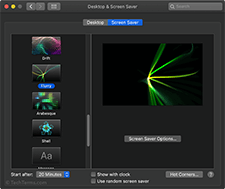Screen Saver
A screen saver, or "screensaver," is an animation that appears on a screen when the device has been idle for a certain amount of time. Screensavers were created to prevent screen burn, where images would get physically "burned" into a screen when they did not change for a long time. For this reason, screensavers include continual animations or frequently changing images that do not stay in the same place very long.
Screen burn was primarily an issue with CRT monitors, which were replaced by flat-screen displays in the early 2000s. While flat-screen devices are less susceptible to screen burn, users had become so used to screensavers, modern desktop operating systems such as Windows and macOS still include them. Additionally, screen burn may affect some LCD and OLED displays, including televisions, especially as they age. So screensavers still have a functional purpose today.
Screen Saver vs Desktop Background
The terms "screen saver" and "desktop background" are sometimes used interchangeably, but they are two different things. A screensaver is an animation that appears on the screen when a device is idle. A desktop background, or wallpaper, is an image that stays on the desktop while the device is in use. Mobile devices typically have a desktop background, but no screen saver option.
You can customize both the screen saver and desktop background in the Windows Control Panel or macOS System Preferences. Screensaver options typically include the screensaver type, animation options, and idle time before the screensaver begins. You can also choose a "hot corner" that allows you to start the screensaver immediately by dragging the cursor to a corner of the screen.
 Test Your Knowledge
Test Your Knowledge